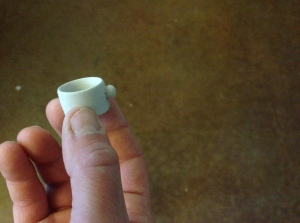I’ve been thinking a lot about cups lately. Some of my students would argue that I think about cups 24-7, but I really do make time for other things. Like bowls.
The featured picture is of Alex’s cup. My Ceramics 3 students are making 25 mugs, and at the start of this project, we discovered that Alex had an unexpected talent for making really small objects on the wheel. This is not easy to do. When you’re throwing tiny, the slightest twitch of the finger renders your piece hopelessly off-center… but if it does survive, then there is trimming to consider. Alex’s ability to throw and trim with dentist-like precision surprised all of us – most of all, him. He is having a blast making these pieces, and I think we all learned something about finding joy in the unexpected.
Here’s another unexpected joy of this week. I was reviewing student sketchbooks from this class, and found the acronym M.U.G. – Makers Urging Greatness – doodled on a page. I was awestruck. I don’t know if I’ve ever read so dead-on accurate a description for how I perceive the role of makers in our complicated world. Greatness is what happens in learning when assessments and outcomes are authentic – when these matter beyond the self and the short-term number in a box. I know a class is working when the students forget about the numbers in boxes, and instead are working towards making a quality product that has some real-world meaning.
This is ‘How a Handmade Cup Can Save the World’ – it’s a bridge to greatness. The transition from making something that matters only to self (making the grade or acing the test) to making something that matters in the world (a cup, or a solution to a problem, or an invention) is the message that the maker sells so eloquently.
My intro level students are making cups right now, too, and I’m slowly starting to see this message sink in. The first day that we sit at the table for handles and finishing, I present that the cup is the only work of art that is meant to be touched, tasted, and seen. (I’m sure there are some other contemporary works of Art out there stretching the senses like this, but the cup is the only one at the high school level!) This doesn’t make sense to them at first, but, one by one, I’ve been watching the object start to take on its own importance. It happens in different ways. One student realizes he’s lost track of time as he’s spent an entire class period sponging and crafting one cup. Another tries to duplicate an upperclassman’s cup, and stumbles on his own unique style in the process. Another decides to scrap all of his original pieces because he knows – he just knows, now – that he’s capable of better. The products are getting exponentially better, and my students are starting to take pride in their work. The grade no longer matters (although those are improving, too) – but the cup, and the process of making it, now matters more than these students could have imagined.
The concept of making can’t be one reserved for the art studio… and we certainly don’t reserve the rights to greatness. But when I see my Ceramics students shift from holding grades as the priority to placing value on their process and product, I wonder why this is happening in a subject as esoteric as clay? Let’s face it – a handmade cup won’t actually save the world; but a new equation, scientific process, or carefully smithed call to action just might. When it comes to relevance to the real world, my subject seems to be at the bottom of the totem pole. And yet, I’m lucky enough to see greatness being made every day.
It might just be the maker’s job to urge for this type of greatness… everywhere. What if making was less about the cup – and more about the habit?
You need the cup to get to the habit, of course, but the habit of not accepting less than one’s authentic, best, impactful work… maybe that’s what the maker really learns and teaches.
Maybe that’s the greatness we makers need to spend more time urging for….
—-
A few of my ceramics students were recently talking about the presentations they have to complete in a much-respected English teacher’s class. I consider this teacher to be one of the best makers I’ve ever known, even though he’s never touched clay in his life. On presentation day, these students arrive to homeroom with immaculately pressed suits, spit-shined shoes, and nervous expressions. Presentations might be about medieval literature or Shakespeare, but students approach these topics as though they were delivering the state of the union.
I remarked that I’d love to sit in a class on presentation day sometime, just to see how the class and the teacher’s assessment worked.
A thoughtful student maker remarked, “I wish more teachers would sit in on his classes. If they did… well, I think you’d all see what we are really capable of.”
—-
Whether it’s tiny cups, unexpectedly great doodles, polished presentations, or impactful conversations, I’m grateful for all the MUGs in my world. Because it’s the transformative power of the maker – and how s/he sees potential, authenticity, and meaning – that might just make a difference.








“Whether it’s tiny cups, unexpectedly great doodles, polished presentations, or impactful conversations” …..or making a blog posting that is capable of motivating others.
Thanks for an inspirational read